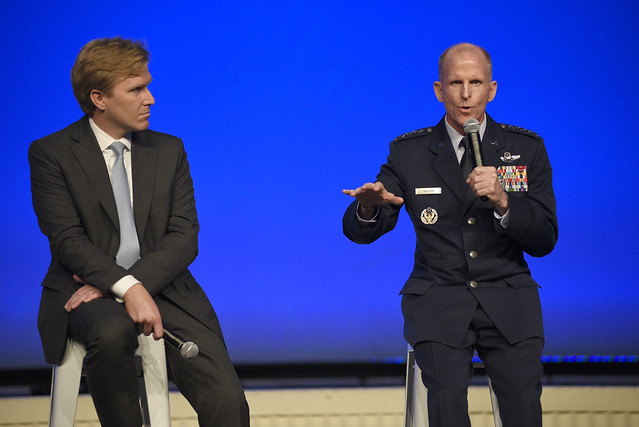
Elbridge Colby, former DOD deputy assistant secretary for strategy and force development, and USAF Vice Chief of Staff Gen. Stephen Wilson discuss the National Defense Strategy. Staff photo by Mike Tsukamoto.
The US now sees itself in a new era of great power competition, but the tough choices that presents for the Air Force have yet to fully manifest themselves, experts said Sept. 17 at AFA’s 2019 Air, Space & Cyber Conference.
“We’ve spent a long time looking at what is the Air Force we need (in this new era) … and building that,” said Gen. Stephen Wilson, the service’s vice chief of staff. “That’s what we’ve been spending the last year and a half doing” in response to the 2018 National Defense Strategy.
“Strategy is all about priorities,” added Elbridge Colby, former DOD deputy assistant secretary for strategy and force development, and one of the NDS’ authors. “We don’t have the abundance of resources We have to make tough choices.”
A key question that document sought to address, he said, was, “What’s the biggest problem out there”
The answer both panelists came back with is a single word: China—which Colby called “The largest competitor we’ve ever faced.”
Colby said that with China, which is growing its military by 7-10 percent a year, “we are facing essentially a peer, especially when you consider that this is taking place in a regional context,” the Western Pacific, where they have a geographic advantage.
“Our economies are roughly comparable in size,” explained Wilson. “Their growth rate is twice what ours is, their population is four times what ours is, and they are graduating eight times as many STEM students as we do Project those numbers forward for a decade, and what does that mean for us” he asked.
“We have to get a sense of urgency and we have to start behaving more like David than Goliath,” he said, calling for a military that is more “nimble and agile.”
And, in an environment where resources are limited, prioritizing means making hard choices as well, Wilson explained. “We are also going to have to prioritize what is the Air Force we don’t need. And that’s where it gets hard and uncomfortable for everybody.”
Wilson said he has begun to question which of the service’s programs don’t fit into the vision articulated by Air Force leaders. “If we can’t connect, if I can’t increase my speed or lethality, then maybe that (program) needs to go into the pile of ‘This is the Air Force I don’t need’ and we take those resources to build the Air Force we do need,” he said.
And it isn’t just the Air Force—the whole nation needs to make difficult decisions about how best to confront a rising and ambitious China. “It’s much bigger than the Department of Defense, it’s bigger even than a whole of government approach, we need a whole of nation effort to get a sense of urgency about what’s going on in the world (and) a clear eyed view of the competition we face,” said Wilson.
One decision implied by the new strategy is to accept more risk in the Middle East from potentially hostile powers like Iran.
“The strategy isn’t saying that everything (else) is going to be hunky dory, especially not in the Middle East,” acknowledged Colby, “But it’s trying to correlate the level of effort and the level of attention to the threats with the consequences of not addressing them.”
This doesn’t mean ignoring the threat from Iran, Wilson said, just recognizing that while “Iran has significant capabilities … they pale, just orders of magnitude, in comparison to China.”
Referring to the career of the defense secretary who oversaw the NDS, Colby said, “Nobody is more CENTCOM than former Gen. Mattis,” who headed up the regional command 2010-13. “But he recognized,” Colby went on, “that the force needs to find ways of dealing more economically with that threat, including through the use of allies and partners.”
The Iranian threat is “urgent but not existential,” Wilson concluded. “Where we cannot get it wrong is in the Western Pacific vis a vis China.”